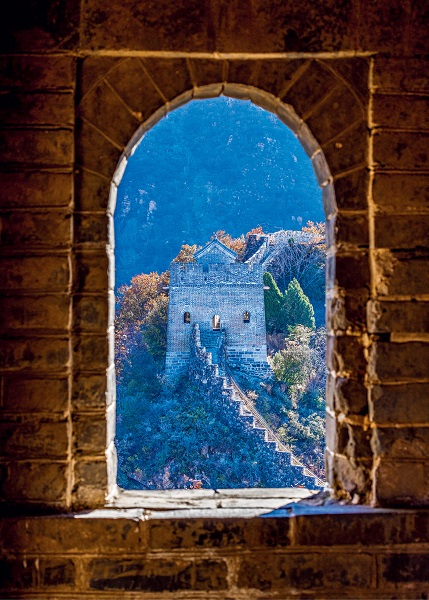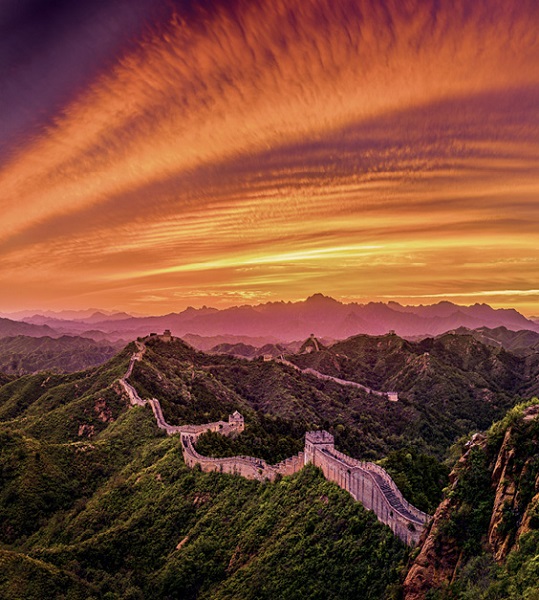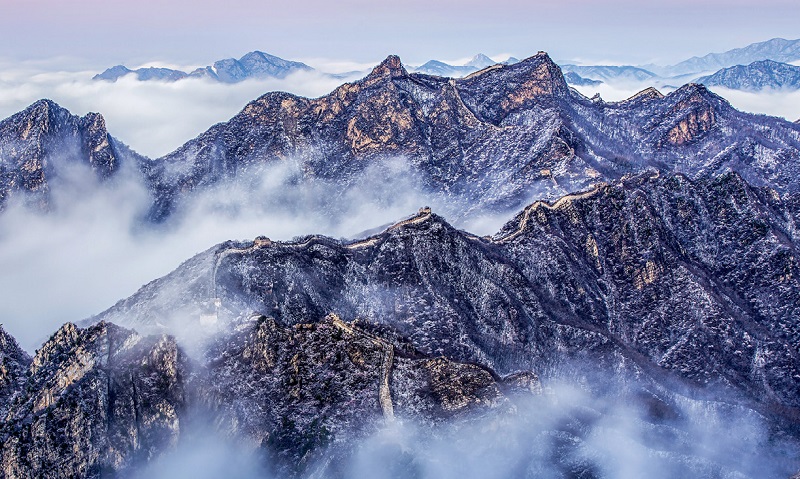
A photo of a beacon tower taken in the Huangyaguan section of the Great Wall in Tianjin City by Yang Dong in October 2020.
For photographers, serendipity is the essential catalyst for seizing a decisive moment. Yang Dong first experienced his in 2016, while taking a rest at the Jinshanling section of the Great Wall in north China’s Hebei Province. Disgruntled at having failed, after several attempts, to find a suitable vantage point for a groundbreaking shot, his serendipity occurred when, as he looked upward, a cloud formation suddenly passed over a Great Wall beacon tower. He immediately grabbed his camera and took the photo which he named Call to Battle, and later won him an award. In ancient times, smoke rising from fires that soldiers lit in beacon towers acted as military signals. The clouds over the beacon tower in Call to Battle resemble such a signal, instantly bringing to mind an ancient battlefield. This is Yang Dong’s most treasured personal photograph.
But underlying that serendipity is a constant accumulation of experience. For over eight years, the primary focus of Yang Dong, born in 1992 in Northeast China’s Liaoning Province, has been to record with his camera the beauty of the Great Wall.

Yang Dong in front of the Great Wall.
The Great Wall Photographic Focus
Originally an amateur photographer, Yang Dong initially decided to specialize in portrait photography. In 2015, he received professional photography training in a supplementary class at the Beijing Film Academy under lecturer Xiao Dianchang. He learned two fundamental requirements in that class: first, photography should entail original ideas. “Copying other people’s photos is not true photography,” Yang Dong always keeps this in his mind, “Photography is only authentic when it reflects your particular vision.” The other is finding the right topic, about which, back then, Yang Dong had no clue.
Seeking out a meaningful theme thus became Yang’s personal quest, which he pursued in his spare time by going out and taking arbitrary shots. His classmates usually took about 200 photos over a weekend, but Yang generally clocked up around 2,000. He recalls his obsession with photography at that time, snapping everything in sight in hopes that he might capture a few precious decisive moments. His efforts paid off. The teacher highly commended some of his works, to the extent of using them as class case studies, and some were used by the media. Before long, Xiao Dianchang told Yang that there was not much more for him to learn in the class. Later, when Xiao started teaching portrait photography, Yang realized that, due to its limited scope, portrait photography was not his cup of tea. So he left.
Like many novice photographers, Yang sought awards that would bring him recognition from professionals. He hence entered his photographs for 50 or more competitions, one of which he sent over 100 photographs. But he received no feedback. This was a huge setback for him, as he recalls, “like a bucket of cold water thrown over me.” But Yang’s passion for photography carried him through these disappointments as he gradually narrowed his photographic scope down to the Forbidden City and the Great Wall.
As Yang was randomly surfing the web one day, looking for the most impressive views of the Great Wall, the Jinshanling section happened to catch his eye. On his first trip there, on September 9, 2015, he was instantly astounded by its magnificent scenery. Having originally planned to spend the day there, he ended up staying for three days in an effort to capture the Great Wall’s splendor. It was his photograph taken at the Jinshanling Great Wall that won him an award for the first time at a competition organized by National Photography a few months later. “As this was my very first award, I was so elated I couldn’t sleep for about a week,” Yang recalled. Since then, Yang’s Great Wall photos have received professional recognition.
Yang subsequently reasoned that, as there are far fewer visitors to the Great Wall than to the Forbidden City, it affords more creative space. And nor does the Great Wall impose set viewing hours and close in the late afternoon. In addition, few young people these days take photos of the Great Wall. Determined to record the beauty of these ancient fortifications through the lens of youth, therefore, Yang found his destined topic.

A photo of the Jinshanling section of the Great Wall in Hebei Province taken by Yang Dong in August 2019.
Through Thick and Thin
As the Great Wall is mainly located on suburban sites, getting there means a long drive for Yang. Taking shots of the Great Wall sunrise or night sky necessitates camping and sleeping there. Imagine how, on a dark night, as one walks alone along the Great Wall armed only with a flashlight, aware that it was both an ancient battlefield and graveyard, any slight scamper of rats or rabbits might bring a shiver, never mind the grunts of larger wild animals. Yang did, at first, feel somewhat vulnerable, but frequent visits have eventually helped him to overcome any such fears. He now feels at home and welcome at the very sight of the Great Wall.
Safety is another issue. Centuries of history have rendered the structure of many sections of the Great Wall absent from the tourist itinerary less than solid. “A blow from one of the bricks that sometimes falls from the Great Wall could be deadly,” Yang said, joking that visitors need to wear safety helmets. Climbing the Great Wall to find the perfect photographic angle, moreover, calls for intensive physical labor, and Yang has to carry dozens of kilograms of photographic equipment up steep routes.
Photographing the Great Wall also requires limitless patience. “I might be satisfied with only one of every 10 photographs I take,” Yang said. Weather is a source of uncertainty. Yang says that taking a photo of a sea of clouds on the Great Wall is only possible if it rains the preceding day. And even if it does, there is a slim chance — about 10 percent — of cloud formations, albeit on the prerequisite that the rainy weather does not extend to the day in question. Once the wind exceeds force three, all clouds will disappear. And as the sun rises and the temperature climbs, the sea of clouds evaporate and blanket the Great Wall, veiling it from human sight.
“You need to come to the Great Wall time and again — 10 or 20 — until the opportunity to take the right photograph arises,” Yang told China Today. “But upon that decisive moment, you forget all the hardships along the way. This, for me, is the allure of photographing the Great Wall.”

A photo of the Jiankou section of the Great Wall in Beijing, surrounded by a sea of clouds and covered by snow, taken by Yang Dong in April 2018. Photos courtesy of Yang Dong
Call of the Wall
At first, winning awards was Yang’s primary goal. But after receiving countless accolades and making national headlines, including winning a gold medal at the 45th New York Photography Awards in 2016 for recording the morning view of the Jiankou section of the Great Wall, he set himself a new goal in 2017: that of helping more people appreciate the Great Wall’s magnificence.
He accordingly set up social media accounts on several platforms, upon which he shared the beauty of the Great Wall with hundreds of thousands of followers.
In 2018, while Yang was photographing the Great Wall in Shanxi Province, he met Lyu Chenggui, one of its local protectors. Lyu told him how his father had protected the Great Wall from damage, and how Lyu himself helped to increase local villagers’ per-capita income from about RMB 1,700 to over RMB 20,000 by protecting and developing Great Wall tourism.
Local villagers have only recently understood the importance of the Great Wall, having previously regarded it as an obsolete, dilapidated structure. They once even appropriated and used wall bricks as building materials. Impressed by Lyu’s decades of efforts to protect the Great Wall, and appreciative of the benefits of Great Wall tourism, however, villagers are now fully cognizant of its importance, and proactive in protecting their ancient cultural heritage.
Touched by this story, and having been witness to its severe damage, Yang relates deeply to the urgency of protecting the Great Wall. “Some of the Great Wall has been damaged by humans, while other damage has been the result of acts of nature, like lightning strikes, blizzards, and earthquakes,” Yang said. According to National Cultural Heritage Administration’s data in 2012, of its total 21,196.18 km length, less than 10 percent of the Great Wall is “relatively well” protected.
When Yang posted online his photographs of damaged sections of the Great Wall, evident in huge cracks, viewers were shocked at its parlous condition, commenting, “How could the Great Wall have come to this?” When Yang sent some of these photos to local authorities, however, they immediately acted to protect these precarious sections.
The Great Wall has spanned China for millennia, weathering wars and storms. It thus reflects the diligence, perseverance, and patriotism of Chinese civilization, a spirit that Yang Dong has set out to record and to celebrate. By 2023, Yang had taken about 60,000 photographs and hundreds of TB of videos of 180 sections of the Great Wall, ranging from Northeast China to Xinjiang Uygur Autonomous Region in the northwest.
Yang Dong has long envisaged himself as spending his life — from youth to old age —photographing the Great Wall, thus gradually adding fresh significance to his work and letting more people appreciate and protect the Great Wall. This is why he will continue to capture the decisive moments at the Great Wall.